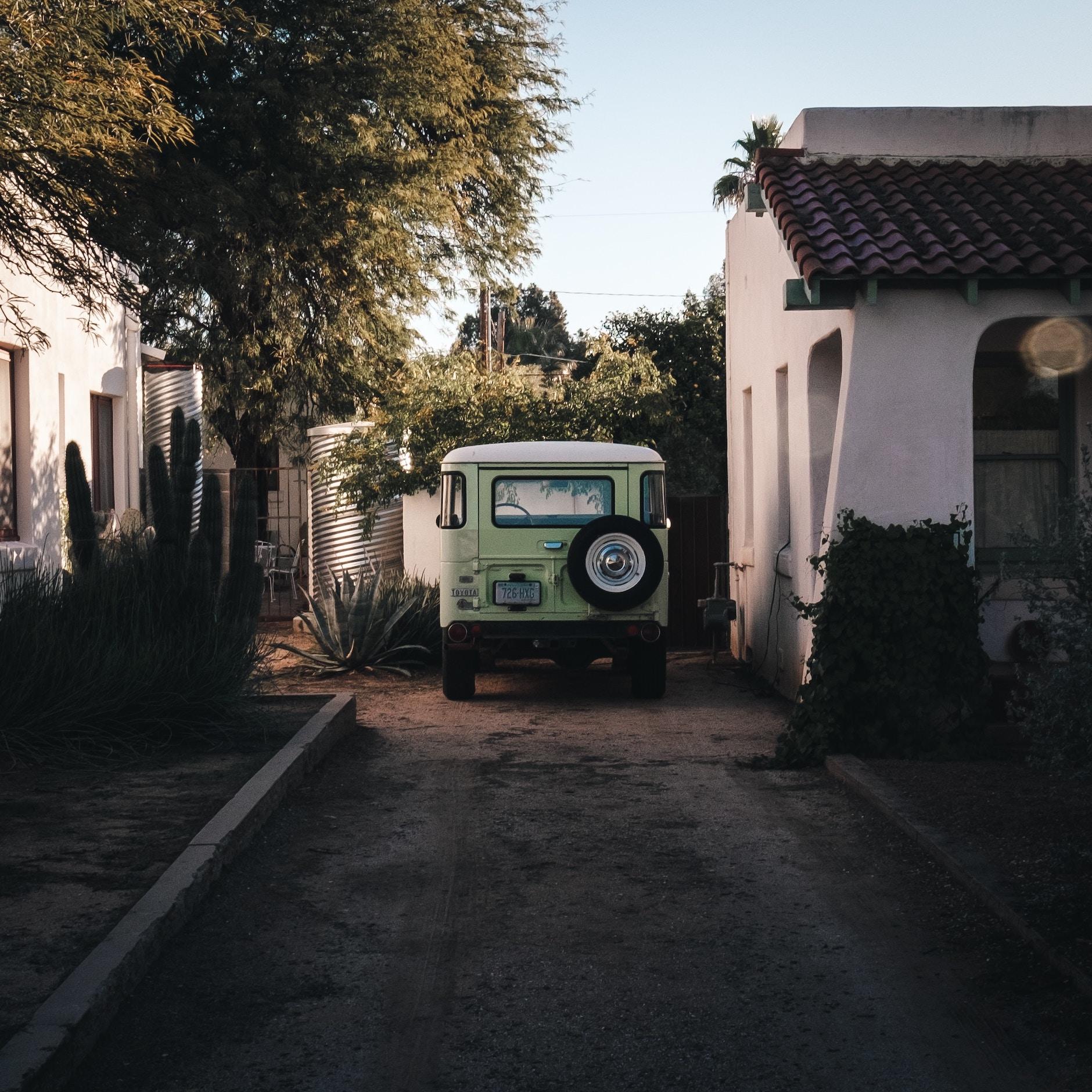Jump Ahead To:
Moving to a new city is always challenging. And a large part of that challenge is looking for a place to live, especially when you have a family. There are so many things to consider when weighing your options and it can be quite overwhelming. That’s why we’ve researched the best neighborhoods for families in Tucson for you, so you don’t have to. You’ve no doubt seen our Tucson City Guide, which includes a short section on a few of Tucson’s most popular neighborhoods.
This list is a more in-depth neighborhood guide meant to examine what it’s like living in each of these highlighted areas. Oh, and by way of introduction, we’re Bellhops—Tucson movers and movers throughout the country).

A Little About Tucson’s Neighborhoods
Tucson is a great place for families. Not only is the cost of living lower than the national average, but it has great schools and entertainment options for kids. It’s surrounded by the largest desert in North America, the Sonoran Desert, with different 12 mountain ranges and the Coronado National Forest. Neighborhoods in Tucson are spread out with all of these natural wonders around them, perfect for family outdoor adventures.
Whether you’re looking to live in the city or one of Tucson’s suburbs, rest assured you’ll find a neighborhood that’s just right for you and your family. And don’t worry, we’re here to help. So, just for you, here are some of the best neighborhoods for families in Tucson.
Sam Hughes
First on our list for best neighborhoods for families in Tucson is Sam Hughes. The Sam Hughes neighborhood is centrally located close to the University of Arizona. You’ll find a mix of university professors, students, artists, young families and professionals living there. Sam Hughes offers easy access to downtown and within walking distance to plenty of shops and restaurants. It’s one of the most diverse neighborhoods in Tucson, with plenty of large, old trees for climbing and parks to play in. It’s also got a great public library. If you’re interested in taking a photographic tour of the neighborhood, Tucson.com offers one. It’ll give you a pretty good idea of the historic beauty of the area.
History
The Sam Hughes neighborhood was named after Samuel C. Hughes, a Welsh immigrant who came to America in 1837 at the age of eight. After settling down in Tucson in 1858, he became a community leader, starting the first bank. He served in the city council and helped establish the city’s public education system. The development of the Sam Hughes neighborhood began in 1921 and it became a national historic district in 1994.
What’s Happening
Probably the most well-known event in this neighborhood is its annual neighborhood home tour, but the neighborhood association hosts other events as well. There are a couple of grocery stores, Natural Grocers and Rincon Market, the Mexican folk art shop Arte de La Vida, a Baskin-Robbins and a handful of other shops.
Schools
The schools near Sam Hughes are among the city’s best. Among them are Sam Hughes Elementary, Second Street Children’s School and Edge High School.
Homes
In this tree-lined area, turn-of-the-century, territorial-style houses, and mission-style bungalows abound. Housing prices start around $200,000 and can go as high as $1.5 million and higher, so there’s some good variety regarding lifestyle.

Dove Mountain
This upscale golf course development is located at the base of the Tortolito Mountains in the suburb of Marana, just north of the city. Dove Mountain has become one of the most popular neighborhoods in Tucson over the last few years, partly because of its easy freeway access. This neighborhood is full of southwest-style stucco houses with muted tones and saguaro-lined streets. Oh, and Tiger Woods and other famous golf players have played in the championship golf course located at the top of the hill within the neighborhood.
History
When Eugene ”Cush” Cayton settled on what is now known as Dove Mountain, the area where he established his T Bench Bar Ranch was predicted by the surveyor to be “…one of the most beautiful spots in the Tucson area.” Cayton stayed there with his family until 1984, where he hosted a wide variety of artists, scientists, prospectors and cowboys. Then he passed his stewardship on to David Mehl, only to become the beloved Dove Mountain community.
What’s Happening
Dove Mountain is all about outdoor activity. There are walking and jogging paths that connect homes to each other as well as to parks and golf courses. And more than 50 miles of hiking and biking trails wind through the community and the surrounding preserve, ranging in elevation from 2,800 feet to 4,300 feet.
There is also plenty of golf, and though the community doesn’t have shopping onsight, it does have easy access to all of the stores, museums and experiences Tucson has to offer.
Schools
Dove Mountain is part of the Marana Unified School District. Students who live in the Dove Mountain resort community may attend three of the public schools within the district, IronWood Elementary, Tortolita Middle School and Mountain View High School. But, in the fall of 2019 Dove Mountain will be home to the new K-8 CSTEM School, which will include a rigorous curriculum of computer science, technology, engineering and math.
Homes
There are 13 neighborhood that make up Dove Mountain, offering an assortment of gated and open communities with plenty of homes in a variety of styles, sizes and price ranges to choose from.
Catalina Foothills
Just north of the city at the base of the Santa Catalina Mountains lies the Catalina Foothills neighborhood, which offers some of the best views of downtown you can get in Tucson. And it’s only a 15-minute drive from the city. This area has a minimalist feel with very few sidewalks and narrow streets that wind through hills. There’s a mix of subdivisions and Southwest-style custom homes there and have all been built to blend in with the desert landscape. Instead of traditional green-grass, the front yards have natural desert landscaping with cacti and desert flowers. And housed in an upscale shopping center are some of the city’s best restaurants, shops and art galleries. The residents who live in the Catalina Foothills are mix of upper-middle class and wealthy retirees, families and professionals, with a population of almost 52,000.
History
Dating back to the early 1920s, land developer John Murphey began buying property north of River Road in the foothills of the Santa Catalina Mountains, where he envisioned 10 subdivisions with large, private, gorgeous mountain and valley views. He eventually contracted Swiss architect Josias Joesler to implement his vision in the 1930s. Joesler also designed the buildings that now make up the Catalina Foothills School District
What’s Happening
The Catalina Foothills offers a multitude of attractions, restaurants and nightlife options. But if you’ve got kids, the Gaslight Theatre and the 4th Avenue Street Fair are great options. Also, Jump Family Entertainment Center, Color Me Mine, Pump it Up Tucson and Our Play Place are all in the area.
Schools
This community is part of the Catalina Foothills School District, which has more than 5,200 students enrolled in eight schools that span Pre-K through 12th grade.
Homes
Homes in the Catalina Foothills area are usually on one story and are on large, private lots with beautiful views of the desert. Interested in living in Catalina Foothills?
El Presidio Historic District
The city’s first, and at one time, most affluent neighborhood, El Presidio is located downtown and features large, historic homes. The area is full of historic art, architecture, food and culture, and is a great place to raise a family
History
Named for the Spanish military garrison that once stood there, El Presidio Historic District is where Tucson began as a modern-day city. In the 1700s, Tucson was taken over by Spanish missionaries and soldiers establishing it as an important colonial outpost in 1775. Then in 1853, Tucson became part of the United States. Today, the district is a combination of historic and modern amenities, where families live within a very rich cultural experience.
What’s Happening
Throughout El Presidio Historic District you’ll find local, regional and Latin American artists who sell their goods inside Old Town Artisans, along with The Tucson Museum of Art and Historic Block and the Presidio San Agustin del Tucson Museum, where family-friendly events are held throughout the year. There’s also the family-owned restaurant Cafe’ A La C’art, a country-style cafe that’s been in operation for more than 14 years.
Schools
Schools in this neighborhood include El Presidio Day School, Museum School for the Visual Arts, City High School and Davis Bilingual Elementary Magnet School, among others.

Armory Park
On the National Register of Historic Places, Armory Park is located downtown and features architectural treasures close to Tucson’s arts and cultural center. One of Tucson’s most desirable neighborhoods, this area is full of architectural styles spanning the last 150 years.
History
With the arrival of the transcontinental railroad in 1880, Amory Park was part of a town plan for Tucson, originally centered around the existing Military Plaza. The neighborhood began to grow primarily along Third and Fourth Avenues, and in 1902, portions of the original Military Plaza were sold to the city, and the remainder became Armory Park. It developed into a stable, progressive neighborhood consisting of mostly prominent, wealthy families. In the 1950s and ‘60s, Armory Park suffered from neglect until it was recognized on the National Register of Historic Sites in ‘74. With the help of private and public investment projects, Armory Park is once again a one of the most popular areas in Tucson.
What’s Happening
Several restaurants are also in the area including Downtown Kitchen + Cocktails, HUB Restaurant & Ice Creamery and Diablo Burger. If you have kids, the Tucson Children’s Museum is located within the neighborhood, a great place to take them on a rainy day. Also located in the area is the Armory Senior Center, which was built in 1975 and hosts many different kinds of senior activities and assistance, including social services, dances, fitness classes.
Schools
Quite a few schools are in the area, include Safford K-8 School, Project MORE High School and Imago Dei Middle School.
Homes
Houses in Armory Park tend to range on the expensive side, going anywhere from around $225,000 for a one bedroom to close to $1.5 million for a six-bedroom house. Victorian, Queen Anne, Greek Revival and Anglo-Territorial-style houses are prominent in the neighborhood, with wide, deep verandas and high pyramid roofs, intricate carved wood detailing and peaked shingle roofs.
There you have it: the best neighborhoods for families in Tucson
Neighborhoods are about location and lifestyle, to be sure. But more importantly, they are about the people who live in them. These neighborhoods offer a variety of lifestyles to meet most anyone’s needs.
We hope this guide to the best neighborhoods for families in Tucson helps you make the right choice to fit your lifestyle. Need to move quickly? We also provide last minute moving services!
- The 5 Best Neighborhoods in Saint Louis (Updated 2024) - March 15, 2024
- Is Moving to Pennsylvania Right for You? A 2024 Guide. - March 4, 2024
- The Best Neighborhoods in Cleveland (Updated 2024) - February 15, 2024




